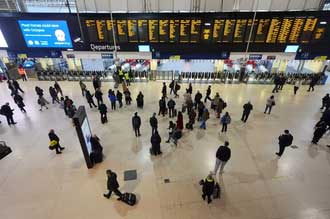Waterloo Station Shutdown: Emergency Incident Throws London’s Commuters Into Chaos
London commuters faced a day of unprecedented disruption today following a serious emergency incident that severely impacted train and tube services across the city, especially at the key hub of London Waterloo Station. The incident, which occurred between Woking and Wimbledon in the South East, prompted emergency responders to take swift action, leading to widespread delays, cancellations, and chaos for thousands of travelers.
Emergency Incident Sparks Major Disruptions
According to South Western Railway (SWR), the disruption began when emergency services responded to an incident on the railway line between Woking and Wimbledon. The nature of the emergency has not been officially disclosed, but authorities confirmed that all lines in the affected section were blocked to ensure safety and manage the situation. The incident prompted a temporary shutdown of power to the railway lines, leaving trains unable to operate through the affected area.
Network Rail Wessex explained that, due to the incident, power supplies had to be turned off to ensure safety during emergency response activities. This power outage meant that no trains could run through the impacted section until the situation was fully resolved and the area was deemed safe for operations to resume. The emergency response teams worked diligently to manage the scene and restore normal service, but the ripple effects of the incident continued throughout the day.
Impact on Waterloo Station and Commuters
One of the most immediate effects of the incident was at London Waterloo Station, one of the busiest railway stations in the UK. Transport for London (TfL) announced that Tube services, particularly the Bakerloo line, would not be stopping at Waterloo to prevent overcrowding and to facilitate emergency response efforts. As a result, passengers faced significant inconvenience, with major queues forming outside the station as travelers struggled to access services.
A spokesperson for TfL explained, “Due to emergency services dealing with this incident, we have had to turn off the electricity that powers the trains. This means that no trains can run through the area, and passengers are being prevented from entering Waterloo Station building.” The situation led to a buildup of frustrated commuters, many of whom were stranded or forced to seek alternative routes.
Widespread Delays and Cancellations
The disruption extended beyond Waterloo, affecting stations between Wimbledon, Woking, Effingham Junction, and Hampton Court. National Rail confirmed that, although the emergency services had completed their work between Wimbledon and Effingham Junction/Hampton Court/Woking, train services remained severely affected. Many trains were canceled, delayed by up to 100 minutes, or revised in schedule to accommodate the ongoing disruptions.
Passengers were advised to check their train statuses before traveling, as the delays were expected to persist until the end of the day. SWR announced that, despite the reopening of the lines, disruptions would continue into the evening hours. The affected routes included not only SWR lines but also connections to other parts of the network, compounding the chaos across London’s transport system.
Alternative Travel Arrangements and Ticket Acceptance
To mitigate the inconvenience caused by the disruptions, transport authorities swiftly implemented alternative travel arrangements. Tickets on affected SWR services are being accepted on alternative bus routes and Great Western Railway services running between Basingstoke and Reading in both directions. Additionally, passengers can use GWR services between London Paddington and Exeter St Davids, which are also accepting tickets as a substitute for affected train routes.
TfL also announced that tickets would be accepted on London buses, providing additional options for commuters stranded by the rail disruptions. Despite these measures, many travelers expressed frustration over the day’s events, citing delays and overcrowding on buses and alternative services.
Ongoing Efforts to Restore Normal Service
Emergency responders completed their work between Wimbledon and Effingham Junction, which allowed some trains to resume service on affected lines. However, the situation remains fluid, with authorities warning that delays and cancellations could persist into the evening. Rail operators are urging passengers to plan ahead, check real-time updates, and consider alternative routes where possible.
Transport officials emphasized that safety remained the priority throughout the incident. As emergency teams continue to investigate and clear the scene, authorities assured the public that they are doing everything possible to restore normal operations as quickly as possible.
Community Response and Future Precautions
The day’s events have sparked widespread discussion about the resilience of London’s transport infrastructure and the importance of safety protocols in emergency situations. Commuters shared their frustrations on social media, with many expressing hope that lessons will be learned to prevent similar disruptions in the future.
Meanwhile, transit agencies are reviewing their response strategies to improve communication and minimize inconvenience during unforeseen incidents. The incident underscores the critical need for robust contingency plans and effective coordination among emergency services, rail operators, and transport authorities.
Looking Ahead
As the day progresses, travelers are advised to stay updated through official channels and consider alternative routes or travel times. While the incident has caused significant disruption today, authorities remain committed to restoring full service as soon as it is safe to do so.
In conclusion, today’s emergency incident at London Waterloo has highlighted both the vulnerabilities and the resilience of London’s transport network. While disruption is inevitable during unforeseen emergencies, swift action and coordinated efforts are vital to ensuring passenger safety and minimizing inconvenience. Travelers are urged to remain patient and vigilant as efforts continue to bring services back to normal.






